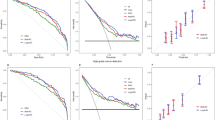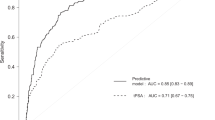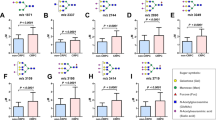Abstract
Introduction: The incidence of clinical prostate cancer in the Arab population is among the lowest in the world. High serum IGF-1 level has been implicated as a possible risk factor for the development of prostate cancer in Caucasians. The purpose of this study was to determine serum IGF-1 and IGFBP-3 levels in healthy Arab men and in Arab men with newly diagnosed benign prostatic hyperplasia (BPH) and prostate cancer, and to compare these values with values reported in Caucasians.
Patients and Methods: Subjects were recruited in two groups: (a) indigenous, healthy Arab men aged 15–90 y (n=383); (b) Arab men with newly diagnosed prostate cancer (n=30) or BPH (n=40). Blood was obtained from fasting patients and volunteers, between 8:00 a.m. and 12:00 noon. The serum concentrations of IGF-1 and IGFBP-3 were determined using Immunoradiometric assay (IRMA) kits.
Results: As in Caucasians, serum IGF-1 and IGFBP-3 levels declined with age in Arab men. The mean±s.d. of serum IGF-1 levels in healthy Arab men in the age group 15–20, 51–60, 61–70 y were lower (376.2±153.2, 134.9±105.7 and 89.6±48.4 ng/ml, respectively), compared to values reported for similarly aged Caucasians. Arab men with newly diagnosed prostate cancer had significantly higher serum IGF-1 level (P<0.01) and lower IGFBP-3 levels (P<0.01) compared to age-matched Arabs without the disease.
Conclusions: Arab men have lower serum IGF-1 levels compared to Caucasians and this may be an important factor in the explanation of the low incidence of prostate cancer in the Arab population.
This is a preview of subscription content, access via your institution
Access options
Subscribe to this journal
Receive 4 print issues and online access
$259.00 per year
only $64.75 per issue
Buy this article
- Purchase on Springer Link
- Instant access to full article PDF
Prices may be subject to local taxes which are calculated during checkout








Similar content being viewed by others
References
Parkins DM et al. Cancer Incidence in Fine Continents. IARC Scientific Publications, 1997, No143, Lyons, France, pp 5–10.
Macaulay VM . Insulin like growth factor and cancer. Br J Cancer 1992; 62: 311–320.
Cohen P, Peehl DM, Lamsom G, Rosenfield RG . Insulin like growth factor (IGFs), IGF-receptors and IGF binding proteins in primary culture of prostate epithelial cells. J Clin Endocrinol 1991; 73: 401–407.
Chan JM et al. Insulin like growth factor-1 and prostate cancer risk: a prospective study. Science 1998; 279: 563–566.
Wolk A et al. Insulin like growth factor, and prostate cancer risk: a population-based case control. J.N.C.I. 1998; 90: 911–915.
Scorilas A et al. Serum human glandular kallikrein (hk2) and insulin like growth factor-1 (IGF-1) improve the discrimination between prostate cancer and BPH in combination with total and % free PSA. Prostate 2003; 54: 220–229.
Chokkalingam AP et al. Insulin like growth factor and prostate cancer: a population-based case-control study in China. Cancer Epidemiol Biomarkers Prev 2001; 10: 421–426.
Khosravi J, Diamandi A, Mistry J, Scorilas A . Insulin-like growth factor 1 (IGF-1) and IGF-binding protein-3 in benign prostatic hyperplasia and prostate cancer. J Clin Endocrinol Metab 2001; 86: 694–701.
Djavan B et al. Insulin-like growth factor-1 (IGF-1), IGF-1 density, and IGF-1 PSA ratio for prostate cancer detection. Urology 1999; 54: 603–608.
Kurek R et al. The significance of serum levels of insulin-like growth factor-1 in patients with prostate cancer. Br J Urol Int 2002; 85: 125.
Cutting CW et al. Serum insulin-like growth factor-1 is not a useful marker of prostate cancer. Br J Urol Int 1999; 83: 996.
Finne P et al. Insulin-like growth factor-1 is not a useful marker of prostate cancer in men with elevated levels of prostate—specific antigen. J Clin Endocrinol Metab 2000; 85: 2744–2749.
Ismail HA et al. Insulin-like growth factor-1 and IGFBP3 for prostate cancer detection in patients undergoing prostate biopsy. J Urol 2002; 168: 2426–2430.
Stattin P et al. Plasma insulin-like growth factor-1 insulin-like growth factor-binding proteins, and prostate cancer risk: a prospective study. J Natl Cancer Inst 2000; 92: 1910–1914.
Harman SM et al. Serum levels of insulin-like growth factor I (IGF-1), IGF-II, IGF-binding protein-3, and prostate-specific antigen as predictors of clinical prostate cancer. J Clin Endocrinol Metab 2000; 85: 4258–4263.
Pollak M . Insulin like growth factor and prostate cancer. Epedimiol Rev 2001; 23: 59–67.
Montzaros CS et al. Insulin like growth factor 1 in relation to prostate cancer and BPH. Br J Cancer 1997; 76: 1115–1118.
Schaefer C, Friedman GD . Insulin like growth factor-1 and prostate cancer. Science 1998; 282: 1999.
Juul A, Bang P, Herte NT . Serum IGF-1 in 1030 healthy children, adolescents and adults: relation to age, sex, stage of puberty, testicular size and body mass index. J Clin Endocrinol Metab 1994; 78: 744–752.
Djavan B, Waldert M, Seitzl C, Marberger M . Insulin-like growth factor and prostate cancer. World J Urol 2001; 19: 225–233.
Grimberg A, Cohen P . Growth hormone and prostate cancer: guilty by association? J Endocrinol Investig 1999; 22: 64–73.
Rosen CJ, Pollak M . Circulating IGF-1. New perspectives for a new century. Trends Endocrinol Metab 1999; 10: 136–141.
Grimberg A, Cohen P . Role of insulin-like growth factors and their binding proteins in growth control and carcinogenesis. J Cell Physiol 2000; 183: 1–9.
Pollak M, Beamer W, Zhang JC . Insulin-like growth factors and prostate cancer. Cancer Metastasis Rev 1999; 17: 383–390.
Rajah R, Valentinis B, Cohen P . Insulin-like growth factor (IGF)-binding protein-3 induces apoptosis and mediates the effects of transforming growth factor-β1 on programmed cell death through a p53- and IGF-independent mechanism. J Biol Chem 1997; 272: 12181–12188.
Kelley KM et al. Insulin-like growth factor-binding proteins (IGFBPs) and their regulatory dynamics. Int J Biochem Cell Biol 1996; 28: 619–637.
Harman SM et al. Serum levels of insulin-like growth factor I (IGF-I), IGF-II, IGF-binding protein-3, and prostate-specific antigen as predictors of clinical prostate cancer. J Clin Endocrinol Metab 2000; 85: 4258–4265.
Signorello LB et al. Insulin-like growth factor-binding protein-1 and prostate cancer. J Natl Cancer Inst 1999; 91: 1965–1967.
Wright NM et al. Demonstration of a lack of racial difference in secretion of growth hormone despite a racial difference in bone mineral density in premenouposal women—a clinic Research center study. J Clin Endocrinol Metab 1996; 81: 1023–1026.
Powell IJ . Prostate cancer and African-American men. Oncology (Huntingt) 1997; 11: 599–615.
Cohen P et al. Biological effects of prostate specific antigen as an insulin-like growth factor binding protein-3 protease. J Endocrinol 1994; 142: 407–415.
Kanety H et al. Serum insulin-like growth factor-binding protein-2 (IGFBP-2) is increased and IGFBP-3 is decreased in patients with prostate cancer: correlation with serum prostate-specific antigen. J Clin Endocrinol Metab 1993; 77: 229–233.
Cohen P et al. Elevated levels of insulin-like growth factor binding protein-2 in the serum of prostate cancer patients. J Clin Endocrinol Metab 1993; 76: 1031–1035.
Ho PJ, Baxter RC . Insulin-like growth factor-binding protein-2 in patients with prostate carcinoma and benign prostatic hyperplasia. Clin Endocrinol 1997; 46: 333–342.
Shariat SF, Lamb DJ, Kattan MW . Association of pre operative plasma levels of IGF-1 and IGFBP-3 with prostate cancer invasion, progression and metastasis. J Clin Oncol 2002; 20: 841–853.
Thissen JP, Ketelsegers JM, Underwood LE . Nutritional regulation of the insulin-like growth factors. Endocr Rev 1994; 15: 80–101.
Li L et al. Relation of serum insulin-like growth factor-1 (IGF-1) and IGF binding protein-3 to risk of prostate cancer (United states). Cancer Causes Control 2003; 14: 721–726.
Renehan AG et al. Insulin-like growth factor (IGF-1), IGF binding protein-3 and cancer risk: systematic review and meta-regression analysis. Lancet 2004; 363: 1346–1353.
Stattin P et al. High levels of circulating insulin-like growth factor-1 increase prostate cancer risk: a prospective study in a population-based non-screened cohort. J Clin Oncol 2004; 22: 3104–3112.
Madami KA . Food consumption patterns in Saudi Arabia. In: Musaiger AO, Milach SS (eds) Food Consumption Patterns and Dietary Habits in the Arab Countries of the Gulf. FAO Regional Office for the Near East, Cairo, 1995; pp 50–57.
Kehinde EO . Prostate cancer in the Middle East: Perspective from Oman. In: Belldegrum A, Kirby RS, Oliver RTD (eds) New Perspective in Prostate Cancer. ISIS Medical Media, Oxford, 1998; pp 383–390.
Hanash KA et al. Prostatic carcinoma: a nutritional disease? conflicting data from Kingdom of Saudi Arabia. J Urol 1999; 161 (Suppl): 71.
Acknowledgements
This project was supported by Kuwait University Research Grant MS01/99.
Author information
Authors and Affiliations
Corresponding author
Rights and permissions
About this article
Cite this article
Kehinde, E., Akanji, A., Mojiminiyi, O. et al. Putative role of serum insulin-like growth factor–1 (IGF-1) and IGF binding protein-3 (IGFBP-3) levels in the development of prostate cancer in Arab men. Prostate Cancer Prostatic Dis 8, 84–90 (2005). https://doi.org/10.1038/sj.pcan.4500783
Received:
Revised:
Accepted:
Published:
Issue Date:
DOI: https://doi.org/10.1038/sj.pcan.4500783



